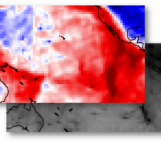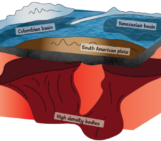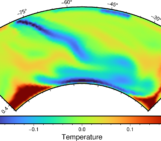![T for temperature in seismic [T]omography and more](https://blogs.egu.eu/divisions/gd/files/2023/10/Featured-image-1-700x400.jpg)
Seismic tomography, a powerful geophysical technique, is like the Sherlock Holmes of the Earth’s interior. It helps us uncover crucial information about the lithosphere and mantle, including temperature and density distributions. Understanding these physical properties is vital for a wide range of geological applications, from identifying regions of strain localization to assessing geothermal potential. In this blog post, Ajay delves into the interpretation world of seismic tomography. In particular, he introduces us different ways seismic tomography models could be used to quantitatively determine temperature conditions within the Earth’s upper mantle. The blog ends with a list of available tools that allow for a quantitative interpretation of the tomography models. Hence, this blog post aims to connect the geodynamics community with available tools.

Ajay Kumar is a geophysicist who is interested in thermo-chemical and thermomechanical evolution of the lithosphere. At present he is working as a post-doc at GFZ Potsdam focusing on the present-day thermomechanical architecture of the lithosphere and upper mantle beneath the Alps and implications for the surface deformation.
In general, seismic tomography models report relative positive or negative velocities with respect to a reference model which are further inferred qualitatively as cold or hot regions in the upper mantle, respectively. Classically, +ve velocity anomalies are qualitatively interpreted to be cold, hence allowing for a geodynamic interpretation, e.g., a subducted slab. But the question is what should be the threshold (1%, 3%) that has implications on the volume of subducted slabs. There exist semi-quantitative methods (e.g., vote maps) that allow one to make robust interpretations out of an ensemble of tomography models, however, one still needs to decide on a threshold. What should be the criteria to choose this threshold is not clear (maybe there is one…).
Since, seismic tomography images the variations in the elastic properties, fundamentally, these variations are controlled by the prevalent physical state (P-pressure, T-temperature, X-composition). Hence, it would be possible to interpret these variations for the former. Quantitative interpretation of the seismic velocity anomalies in terms of temperature and/or chemical composition is challenging (mainly because of the non-linearity) and is at the forefront of modern-day geophysics.
Conversion of seismic velocities to temperature/density has been employed since the early 2000 leveraging on the mineral physics studies of elastic properties of dominant minerals (e.g., olivine) in the mantle and their P-T dependence. These results are then used for inverting seismic velocities for the temperature and density variation. However, in this approach, one needs to make assumptions about the dominant composition of the mantle (i.e., majority olivine and other Al, Na, Ca phases). Although one can formulate the conversions by varying the mineral proportion in space, there is a more general way, the thermodynamics approach, that involves computing mineral proportion as a function of temperature and pressure (i.e., Perple_X). The thermodynamics-based approach takes a more chemical perspective based on bulk average chemical composition described in terms of major oxides (SiO2, MgO, FeO, CaO, Al2O3).
Contrary to the thermodynamics-based approaches, there exist empirical approaches, where one calibrates tomography models to known temperature distributions. These known distributions usually come from age-dependent oceanic lithosphere thermal structure, and/or temperatures derived from mantle xenoliths in continental regions. This approach is like using familiar landmarks to navigate in an unfamiliar terrain.
Another approach that has emerged, from the “LitMod approach” (see another blog post by Juan Carlos Afonso), that combines thermodynamics with geophysical and seismological data. This approach considers not only the composition of the mantle but also other geophysical data such as potential fields and topography, along with seismological data like surface wave dispersion curves and receiver functions. This fusion of different data sources provide a more comprehensive picture of what’s happening beneath our feet.
What if you are not a seismologist or you are simply interested in quantitatively interpreting a tomography model in your study area? There are open-source/free tools that allow you to convert seismic velocities to temperature and/or density. Following is the list of open and free-to-use tools that are available (at least the ones that I could find). For information, about these tools, the reader is referred to the corresponding websites.
Available tools:
V2RhoT_gibbs: https://github.com/ajay6763/V2RhoT_gibbs
VeloDT: https://github.com/cmeessen/VeloDT
VelocityConversion: https://github.com/cmeessen/VelocityConversion
Phemgp: https://github.com/inverseproblem/Phemgp/tree/master
WISTFUL: https://github.com/wshinevar/WISTFUL
In conclusion, seismic tomography is a remarkable tool that helps us unlock the secrets hidden beneath the Earth’s surface. While interpreting tomography models is a challenging task, the development of open and free-to-use tools (see the list above) is pushing the boundaries of what we can achieve/infer from seismic tomography models. With these advancements, we are getting closer to unravelling the mysteries of the Earth’s temperature and composition, paving the way for a deeper understanding of our planet’s dynamic processes.
References
Afonso, J. C., J. Fullea, Y. Yang, J. A. D. Connolly, and A. G. Jones. 2013. “3-D Multi-Observable Probabilistic Inversion for the Compositional and Thermal Structure of the Lithosphere and Upper Mantle. II: General Methodology and Resolution Analysis.” Journal of Geophysical Research: Solid Earth 118(4):1650–76. doi: 10.1002/jgrb.50123. Cammarano, Fabio, Saskia Goes, Pierre Vacher, and Domenico Giardini. 2003. “Inferring Upper-Mantle Temperatures from Seismic Velocities.” Physics of the Earth and Planetary Interiors 138(3–4):197–222. doi: 10.1016/S0031-9201(03)00156-0. Fullea, J., S. Lebedev, Z. Martinec, and N. L. Celli. 2021. “WINTERC-G: Mapping the Upper Mantle Thermochemical Heterogeneity from Coupled Geophysical–Petrological Inversion of Seismic Waveforms, Heat Flow, Surface Elevation and Gravity Satellite Data.” Geophysical Journal International 226(1):146–91. doi: 10.1093/gji/ggab094. Kumar, Ajay, Manel Fernàndez, Ivone Jiménez‐Munt, Montserrat Torne, Jaume Vergés, and Juan Carlos Afonso. 2020. “LitMod2D_2.0: An Improved Integrated Geophysical‐Petrological Modeling Tool for the Physical Interpretation of Upper Mantle Anomalies.” Geochemistry, Geophysics, Geosystems 21(3):1–19. doi: 10.1029/2019GC008777. Munch, F. D., Khan, A., Tauzin, B., van Driel, M., & Giardini, D. (2020). Seismological evidence for thermo-chemical heterogeneity in Earth's continental mantle. Earth and Planetary Science Letters, 539, 116240. Priestley, Keith, and Dan McKenzie. 2013. “The Relationship between Shear Wave Velocity, Temperature, Attenuation and Viscosity in the Shallow Part of the Mantle.” Earth and Planetary Science Letters 381:78–91. doi: 10.1016/j.epsl.2013.08.022. Shinevar, William J., Oliver Jagoutz, and Mark D. Behn. 2022. “WISTFUL: Whole‐Rock Interpretative Seismic Toolbox for Ultramafic Lithologies.” Geochemistry, Geophysics, Geosystems 23(8). doi: 10.1029/2022GC010329. Zunino, A., J. A. D. Connolly, and A. Khan (2011), Precalculated phase equilibrium models for geophysical properties of the crust and mantle as a function of composition, Geochem. Geophys. Geosyst., 12, Q04001, doi:10.1029/2010GC003304




